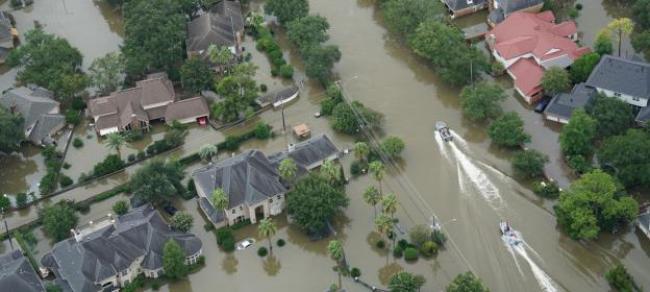STRATEGY – BLOG
 How virtual networks can encourage resilience in a disaster.
How virtual networks can encourage resilience in a disaster.
Hurricane Harvey was one of the biggest flood-producing storms in United States history. On the heels of Harvey, hurricanes Irma and Jose bore down on the Caribbean and U.S. This is apparently a sign of things to come, as climate-changed hurricanes will become wetter and rainier. And it’s not just North America; recent extreme floods in India, Bangladesh and Nepal resulted in 1,200 deaths and left millions homeless. In July of this year, large hailstones hit Istanbul, causing excessive damage. The United Nations has called for cities to build resilience to climate change.
Crisis situations – terrorist acts or ‘natural’ disasters – are increasingly part of our lives. Wherever a crisis is experienced, it is now felt around the rest of the world, via pictures, videos and text. This can create a sense of being there and of solidarity, which may have benefits. In the digitalised world, social media helps people to cope with crises.
During Hurricane Harvey, hundreds of Houston residents sought assistance through social media. For example, wheelchair-bound residents at a care home were stuck on the ground floor, immersed in rising water from the flood. Emergency services were not available. The care home owners decided to post a picture of the residents’ plight on Twitter, which then went viral, leading to the rescue of the residents. Others were also saved after posting on Twitter and Facebook.
Of particular note is the way in which communities drew together, with residents using their own initiative and resources, for example, using privately owned boats to search for and rescue neighbours whom overstretched emergency services were unable to help.
Notably useful was the social media app Zello which, like a walkie-talkie, allows users to speak to large groups of people. Zello broadcast the Cajun Navy and helped both emergency services and locals rescue people in the aftermath of Harvey. It was a hit on the Apple App Store during both Harvey and Irma.
Social media can help us work together and survive crisis situations on a practical level. But how can it assist us in becoming more resilient during times of crisis?
Foster resilience with an app
For my EMCCC degree, I studied how executives use the messaging platform WhatsApp during crisis situations.
Resilience relates to people’s ability to positively adapt to adverse circumstances. It is an important factor, affecting individuals and teams while helping them adapt to adversity and perform well. There are certain ways in which I found WhatsApp groups contributed to team resilience in a professional setting.
• Connectivity When a person is faced with adversity, their learning potential is enhanced by their relationships. Researchers suggest that high-quality relationships are especially important for resilience. Individuals and the teams they belong to are better able to collectively grasp difficult situations and also figure out the best way to deal with them. Connectivity is a vital tool because it enables teams to seize possibilities and create new ways to increase their capacity to bounce back from negative events, reinforce their resolve and thus increase their capability.
• Trust The expression of both positive and negative emotions is not a contradiction, but rather a balance, with both aspects complementing the other’s potential downsides, enabling adaptive responses towards adversity. Trust is another key quality in enabling resilience in teams. Trust allows team members to be vulnerable to one another, and is a good base for the expression of emotions. An exploratory study has shown that trust can exist in teams built purely on virtual networks.
• Collective action When faced with crisis situations, intensified sharing and increased connectivity through social media might bolster resilience in teams, particularly those which already primarily operate in the virtual context. In addition, the accelerated connectedness facilitated by social media tools such as WhatsApp may also enable enhanced emotional expression within teams. This would likely facilitate team resilience because the sense of being a part of a group or simply feeling that one is not alone allows collective action or behaviour or actions of a group working towards a common goal. This may go some way towards accounting for the community response we saw in the wake of Hurricane Harvey.
• Safety checks After analysing data generated by an online survey and semi-structured interviews, I identified a major benefit of using WhatsApp groups during crises: the ability to conduct safety checks within business groups. These involve each group member confirming his or her presence after an emerging crisis. WhatsApp, with its instant, synchronous, reciprocal communication, has replaced existing procedures as a method of transmitting safety, thus creating immediate connectedness.
Communication in a crisis
Hurricane Harvey has shown us that social media supports people working together towards a common goal and can be used to manage collective action. Another app, Line, the most widely used social media platform in Japan, grew out of the 2011 earthquake and tsunami. People urgently need to communicate during crises – they need to cry for help or let loved ones know they are safe. Sharing emotions freely and feeling connected to a group, especially in adverse situations, can improve virtual group dynamics which may lead to more collective action and the cultivation of resilience.
Social media might also be used to raise issues about crisis response and the lessons that follow. Taking these points into consideration, it would be beneficial for organisations to support the formation of virtual communities, especially in times of uncertainty.
Iffet Turken is an executive board member at Kässbohrer, actively involved in international associations for transportation, and a recent graduate of INSEAD Executive Master in Consulting and Coaching for Change.
This article is republished courtesy of INSEAD Knowledge. Copyright INSEAD 2017.


